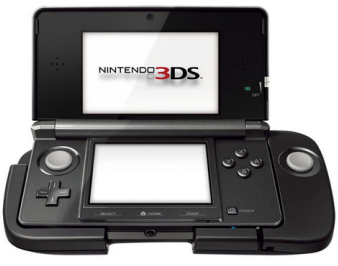By Joel Smart (The Cascade) – Email
Date Posted: September 27, 2011
Print Edition: September 21, 2011
 Fans of Nintendo have had a lot of good news over the last few years, but the 3DS handheld device has been a bit of a mixed bag. On the bright side, the 3DS will soon gain the capability to record 3D video – a feature that may entice those nearly swayed by the recent price drop to finally pick one up. However, it’s a recently announced add-on device that has gamers talking (or should I say grumbling) about the handheld. The unsightly slidepad accessory, which would give the 3DS a second analog stick, adds serious bulk to the total size and shape of the device. It also requires a AAA battery to function. Truly, the choice to add the second stick so late in the game is a sloppy attempt to play catch up to the yet-to-be-released PlayStation Vita.
Fans of Nintendo have had a lot of good news over the last few years, but the 3DS handheld device has been a bit of a mixed bag. On the bright side, the 3DS will soon gain the capability to record 3D video – a feature that may entice those nearly swayed by the recent price drop to finally pick one up. However, it’s a recently announced add-on device that has gamers talking (or should I say grumbling) about the handheld. The unsightly slidepad accessory, which would give the 3DS a second analog stick, adds serious bulk to the total size and shape of the device. It also requires a AAA battery to function. Truly, the choice to add the second stick so late in the game is a sloppy attempt to play catch up to the yet-to-be-released PlayStation Vita.
Owners of the 3DS know that it likely means a revamped version of the 3DS is on the way, with a built-in second analog sick. Increasing this probability is the fact that even before its release, six big-named games have been confirmed to use the slidepad, including the hugely-popular (in non-American markets) Monster Hunter 4. Metal Gear Solid: Snake Eater 3D and Resident Evil: Revelations are also among the games confirmed to use the device. These are the heavy hitters that Nintendo, Sony and Microsoft like to get behind new accessories they want well-supported.
The frustrating thing for people who already own the 3DS is that they’ll wind up being forced to either buy the unwieldy device and walk around with it strapped onto their 3DS like a sucker, or alternately shell out the money to buy an entirely new version once it is released. Neither scenario seems like an especially attractive choice.
It is an increasingly common business strategy from Nintendo, Microsoft and Sony to offer different or updated versions of hardware. It used to be an unspoken rule that the console market was differentiated from the PC market by the fact that all console gamers could play every game for the entire life of the console, simply by buying the machine. However, this generation of consoles in particular has featured several different models of quality and function, most noticeably in the Xbox 360’s use of Arcade and Elite. Sony has actually removed functionality from the PS3 since launch. However, the handheld market has been the most to blame for violating this rule, though strangely, again, Sony’s PSP Go actually removed functionality from the original PSP (though later versions of the PSP have more functions than the early PSPs). Nintendo has gone the furthest, though, offering numerous updated hardware models that change the functions and ability of its handhelds mid-generation.
The 3DS change is actually more akin to the choice of Sony to change the default controller of the PlayStation 3 to the DualShock 3 – except that in this case, players would have to repurchase the entire device if they don’t want to suffer with a poorly-designed, oversized accessory. For a device that is already really struggling to sell, it could signal the beginning of the end for the 3DS (and Nintendo’s reign of dominance).

